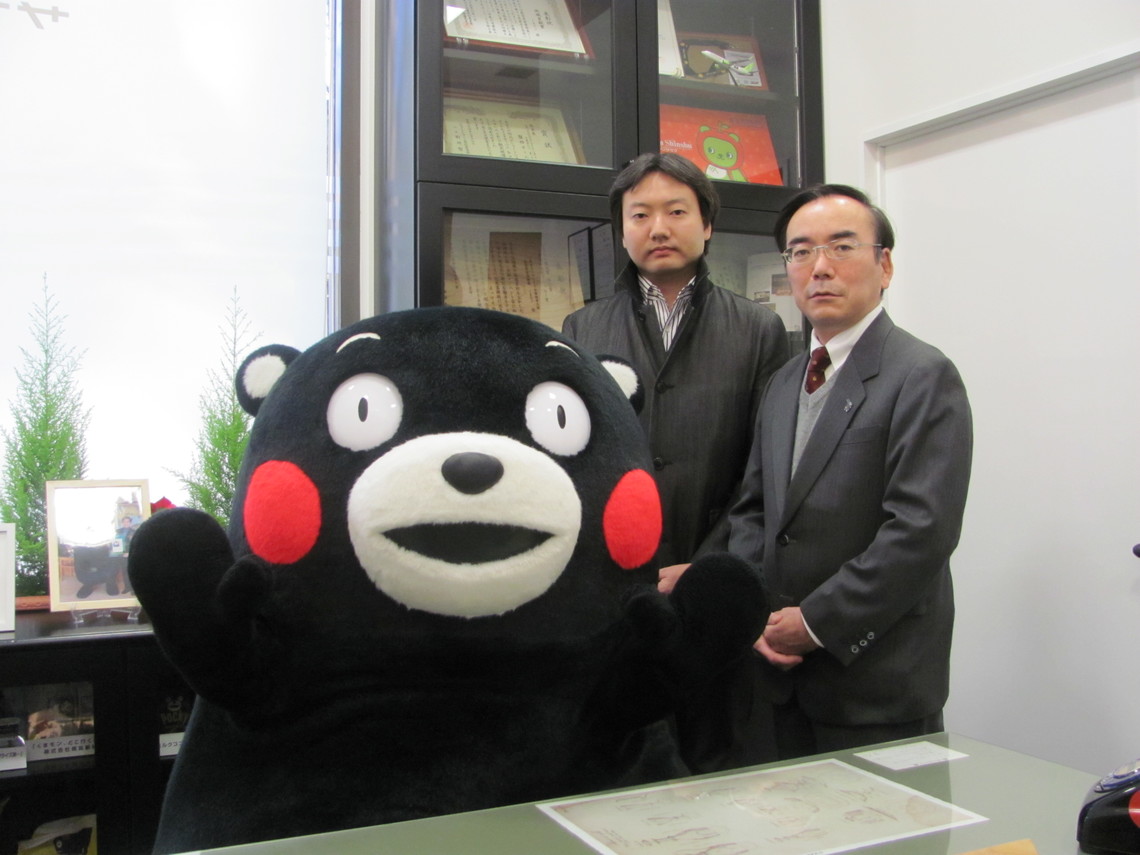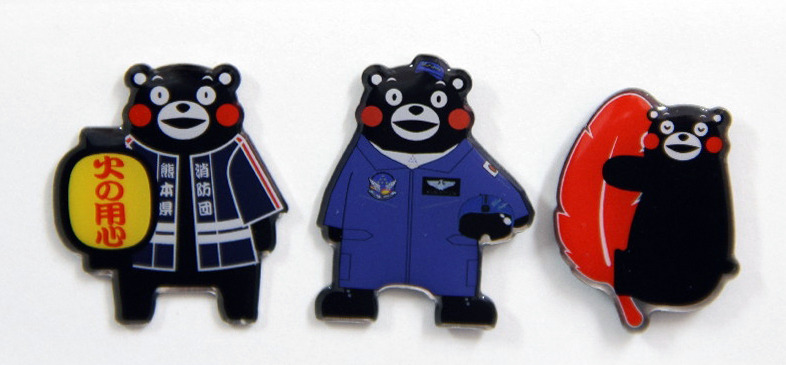Now in its fourth year as Kumamoto Prefecture's PR mascot, the iconic Kumamon—known for its bright red cheeks—has gained fans across Japan and even overseas, riding a wave of immense popularity.
Its communication strategy serves as a model for considering the role of corporate and organizational mascots.
To explore the secrets behind Kumamon's success, we spoke with Masataka Nario, Director of the Kumamoto Brand Promotion Division. He is one of Kumamon's creators and the author of "The Secret of Kumamon" (Gentosha Shinsho, 2013).

The Birth of Kumamon: What Was Happening in Kumamoto at the Time...
Yamamoto: I imagine you've been asked many times, "What's the secret behind Kumamon's hit?" So today, let's start with a curveball question. What was your first impression of Kumamon?
Naruo: Honestly, for better or worse, I didn't have a particularly strong impression of him at that moment. We had asked Mr. Kundo Koyama to be an advisor for the Kyushu Shinkansen's inaugural year projects leading up to the full line opening. He proposed the catchphrase "Kumamoto Surprise," and Kumamon was a character proposed as a sort of "bonus" attached to that campaign logo. We hadn't actually asked for character proposals in the first place...
Yamamoto: So, among the staff members, were there any who were initially a bit taken aback by this unexpectedly sudden appearance of a black bear (laughs)?
Naruo: For municipal mascots, designs often start with motifs reflecting the area's characteristics or main industries. So, where exactly did this character embody Kumamoto? We could see the red cheeks symbolizing Otemoyan or the "Land of Fire," but bears aren't associated with Kumamoto. Some genuinely worried it might give Kumamoto a rustic impression.
Yamamoto: The reason I asked this question first is that, in my own work developing corporate characters, I've come to feel that inner motivation is crucial for nurturing corporate characters broadly—not just for private companies, but for government agencies and various organizations too. So, at what point did those initially skeptical people change their minds, leading to Kumamon's current level of popularity?
Naruo: I think the surge in popularity in Kansai was significant. As part of the Shinkansen inaugural year project, one mission was to raise Kumamoto Prefecture's recognition in Kansai. As Kumamon's popularity gradually grew there, both the prefectural residents and the staff naturally started feeling, "Hey, Kumamon's pretty cool."
Yamamoto: Mr. Nario, did you yourself gradually grow to like Kumamon as you worked on communications?
Nario: That's right. I'd been doing steady PR work even when Kumamon was still relatively unknown in Kansai. The moment I witnessed it was unforgettable: seeing the incredibly long line for Kumamon's autograph session at the Kumamoto Specialty Fair event held in Osaka's Namba district, just one month before the Shinkansen opened.
Yamamoto: So that moment was precisely when your level of fandom for Kumamon changed, right?
Naruo: Seeing Kumamon surrounded by so many fans and truly embraced with my own eyes was huge. That's why even now, I make sure new staff members get out into the field as soon as possible, so they can experience Kumamon's popularity firsthand.

Expanding into the real world broadened the target audience
Yamamoto: Earlier, near the entrance of Kumamon Square (the facility promoting Kumamon information and Kumamoto Prefecture's tourism and products), there was an older gentleman hugging Kumamon for a photo. Kumamon's target audience is really broad, isn't it?
Naruo: Absolutely. I might get scolded for saying this, but initially, I had this image that characters like this were mainly popular with kids and women. But when Kumamon was born and we opened the floodgates, the first fan appreciation day in Osaka drew a truly diverse crowd of all ages and genders. I was surprised to see quite a few "uncles" (in Osaka dialect) there too.
Yamamoto: When consulting on corporate characters, I often hear people from companies say, "Aren't characters only appealing to kids and women?" Of course, the level of enthusiasm for a character varies depending on the target audience, but I also explain that Japanese culture as a whole has a high receptivity to characters. But from now on, I think I'll use Kumamon as an example (laughs).
Naruo: Honestly, I'm surprised too. That it's popular across the board, even with us older guys. Though lately, some folks might just want a photo with the famous Kumamon to brag to their friends (laughs).
Yamamoto: Unlike anime or flat media, focusing on the real world through mascot costumes might have helped foster affection for the character across a broad target audience. Unlike private companies, government entities often need broad outreach without narrowly targeting specific groups. In that sense, Kumamon's communication strategy really seems to be working well.
A design so simple it's easy to adapt
Naruo: Seeing the constant stream of licensing requests for Kumamon merchandise from all over, I feel that its broad appeal actually stems from the simplicity of Kumamon's design. For example, Kumamon dressed in camouflage was insanely popular at the Self-Defense Forces' commissary...
Yamamoto: Wow, there's even a Self-Defense Forces version?
Naruo: Beyond that, Kumamon in a white coat with a stethoscope is used by medical associations, Kumamon holding grapes is used by sommelier associations, and he's also effectively utilized by fire departments, social welfare councils, and various other organizations.
Yamamoto: Right. While he's often called a "yuru-kyara" (cuddly mascot), Kumamon's design truly combines flexibility and adaptability. I've always felt it's actually very strategically calculated.
Naruo: It's not just about being an organization's symbol. For example, when Kumamoto Prefecture hosted the "National Rich Sea Creation Conference" last year, we dressed Kumamon in a happi coat featuring a fishing flag pattern to make him the event's character. As you know, the design is by art director Manabu Mizuno. If he aimed from the start to convey diverse messages to a broad target audience, that's truly impressive.

Yamamoto: It's not just about being cute; that functional design, making it easy to adapt for various applications, is a major reason for its success, right?
Naruo: The hit is a happy problem, but I feel like Kumamon's expansion happened so fast that it peaked all at once. I'm constantly worried it might crash just as suddenly (laughs). It could have been a bit slower, you know.
Is Kumamon a once-in-a-century savior?!
Yamamoto: Recently, there's huge focus on owned media and PR tactics. Companies often ask us for "leveraged expansion plans" that deliver similar effects to expensive mass media campaigns. But even with great ideas, getting media attention is tough. In that sense, Kumamon's PR-focused strategy seems incredibly effective. Any secrets?
Naruo: Well, Kumamon originated from the "Kumamoto Surprise" campaign, so our team fundamentally aims to create various PR initiatives that surprise people. This positions us as a constant source of news for the media. Nowadays, when we do something new, we get attention with a high probability. But if you ask me what the initial trigger was, I honestly can't pinpoint it clearly (laughs).
Yamamoto: I wonder what the initial big bang was that led to the current situation. I'm really curious about the winning factors there (laughs).
Naruo: We could speculate about "what ifs," but ultimately, everything just fell into place perfectly. Outside the prefecture, we first made our move in Kansai. During the tough phase of corporate visits, we won the "Yuru-Chara Grand Prix 2011"... And then there's the full opening of the Kyushu Shinkansen line, which stakeholders called a "once-in-a-century opportunity" for Kumamoto. Now, with Kumamon born right at that timing and booming like this, I can't help but think Kumamon might be that once-in-a-century character for Kumamoto – if such a character even emerges.
Yamamoto: I see. It seems we still need a thorough dissection of Kumamon to understand the reasons for his success, so I look forward to continuing this discussion next time!
※Part 2 is scheduled for update on February 19.








